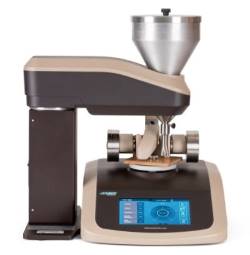Description
The Taber® Grit Feeder Attachment is used in conjunction with the Taber Rotary Platform Abraser (Abrader) to evaluate three-body abrasion caused by the destructive action of fine, hard particles. Originally referenced as the Frick-Taber test, this instrument has been used to determine the wear resistance of flooring products with smooth surfaces.
The Grit Feeder is a freestanding instrument that requires a Taber Rotary Platform Abraser (not included) to conduct testing. The grit distributor nozzle is positioned over the Taber Abraser specimen in front of the right abrasive wheel. During the test, abrasive grit particles are deposited uniformly and continuously onto the specimen surface. As the specimen holder rotates, the loose grit particles pass under a pair of S-39 Leather-Clad Wheels. The resulting rolling action of the particles serves as the abradant and contributes to the physical breakdown of the material.
Models
Depending on the Taber Abraser Model that you have, two Grit Feeder models are available:
Grit Feeder – Model 355 is designed specially to work with the Taber Abraser Model 1700 or 1750. It offers an ‘easy fill’ funnel hopper with a capacity of approximately 2,650 grams. Mounted on either the left or right side of the Taber Abraser, Model 355’s hopper assembly pivots allowing the operator easy access to view or mount the test specimen.
Grit Feeder – Model 255 will work with older versions of the Taber Abraser and offers a hopper capacity of approximately 4,500 grams. An alignment block is incorporated into the base of the Model 255, to ensure the correct location of the grit feeder in relation to the abraser.
Abradants
The standardized abradant supplied with Taber’s Grit Feeder is a #240 aluminum oxide grit particle (Model S-41). Produced specifically for Taber Industries, this aluminum oxide has tighter controls for both particle size analysis and bulk density properties compared to “off-the shelf” aluminum oxide.

